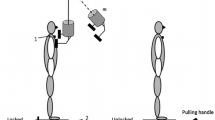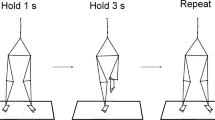Summary
The functional role of spinal and supraspinal EMG-responses for the maintenance of upright human posture was investigated in ten healthy subjects standing on a force measuring platform, which could be rotated in pitch around an axis aligned with the subject's ankle joint. Voluntary changes of body posture prior to the platform movement by leaning forward or backward led to a change in the amplitude and temporal organization of EMG-responses as compared to platform movements starting from a neutral position. Tilting the platform toe-up while leaning backward led to an increase of the latency of the short- and medium-latency responses in the triceps surae muscle and to a decrease of the latency of the stabilizing response in the anterior tibial muscle. Functionally, a cocontraction of both antagonistic muscles could be observed which partly compensated for the destabilizing action of the “reflex” response in the stretched triceps surae muscle. In analogy, leaning forward and tilting the platform toedown led to a cocontraction of the two antagonistic muscles. The observed changes of latencies of short-, medium-, and long-latency response show the functional variability of segmental and suprasegmental “reflex” mechanisms. EMG-activities, which are functionally destabilizing posture, can be suppressed or compensated by reflexive cocontractions of antagonists.
Similar content being viewed by others
References
Allum JHJ, Büdingen HJ (1979) Coupled stretch reflexes in ankle muscles: An evaluation of the contribution of active muscle mechanisms to human posture stability. Prog Brain Res 50: 185–195
Allum JHJ, Mauritz KH, Vögele H (1982) Stiffness regulation provided by short-latency reflexes in human triceps surae muscles. Brain Res 234: 159–164
Chan CWY, Kearney RE (1982) Is the functional stretch response servo-controlled or preprogrammed. Electroencephalogr Clin Neurophysiol 53: 310–324
Diener HC (1982) Zur Physiologie und Pathophysiologie des aufrechten Stehens beim Menschen unter statischen und dynamischen Bedingungen. Med. Habil. Schrift, Tübingen
Diener HC, Dichgans J, Bootz F, Bacher M (1983) Early stabilization of human posture after a sudden disturbance: Influence of rate and amplitude of displacement. Eur J Physiol (in press)
Evarts EV, Granit R (1976) Relations of reflexes and intended movements. Prog Brain Res 44: 1–14
Friedman M (1937) The use of ranks to avoid the assumption of normality implicit in the analysis of variance. J Am Statist Assoc 32: 675–701
Gantchev GN, Draganova N (1976) H-reflex changes in various phases of spontaneous and induced body oscillations. Agressologie 19: 39–40
Ghez C, Shinoda Y (1978) Spinal mechanisms of the functional stretch reflex. Exp Brain Res 32: 55–68
Gottlieb GL, Agarwal GC (1973) Modulation of postural reflexes by voluntary movement. I. Modulation of the active limb. J Neurol Neurosurg Psychiatry 36: 529–539
Gottlieb GL, Agarwal GC (1979) Responses to sudden torques about ankle in man: Myotatic reflex. J Neurophysiol 42: 91–106
Gottlieb GL, Agarwal GC, Jaeger RJ (1981) Response to sudden torques about ankle in man.IV. A functional role of alphagamma-linkage. J Neurophysiol 46: 179–190
Houk JC (1976) An assessment of stretch reflex function. Prog Brain Res 44: 303–314
Iles JF (1977) Response in human tretibial muscles to sudden stretch and nerve stimulation. Exp Brain Res 30: 451–470
Kearney RE, Chan CWY (1982) Contrasts between the reflex responses of tibialis anterior and triceps surae to sudden ankle rotation in normal human subjects. Electroencephalogr Clin Neurophysiol 54: 301–310
Lee RG, Tatton WG (1975) Motor responses to sudden limb displacement in primates with specific CNS lesions and in human patients with motor system disorders. Can J Neurol Sci 2: 285–293
Lee RG, Tatton WG (1982) Long latency reflexes to imposed displacements of the human wrist: dependence on duration of movement. Exp Brain Res 45: 207–216
Melvill Jones G, Watt DGD (1971) Observations on the control of stepping and hopping movements in man. J Physiol (Lond) 219: 709–727
Monster AW (1973) Loading reflexes during two types of voluntary muscle contractions. In: Stein RB, Pearsson KB, Smith RS, Redford JB (eds) Control of posture and locomotion. Plenum Press, New York, pp 347–362
Nashner LM (1976) Adapting reflexes controlling human posture. Exp Brain Res 26: 59–72
Wilcoxon F, Wilcox RA (1964) Some rapid approximate statistical procedures. Lederle Labs., Pearl River, NY
Woollacott MH, Nashner LM (1982) Inhibition of the Achilles tendon reflex by antagonistic long-latency postural responses in humans. Exp Neurol 75: 420–439
Author information
Authors and Affiliations
Additional information
Supported by the Deutsche Forschungsgemeinschaft (Di 278/1-1)
Rights and permissions
About this article
Cite this article
Diener, H.C., Bootz, F., Dichgans, J. et al. Variability of postural “reflexes” in humans. Exp Brain Res 52, 423–428 (1983). https://doi.org/10.1007/BF00238035
Received:
Issue Date:
DOI: https://doi.org/10.1007/BF00238035




